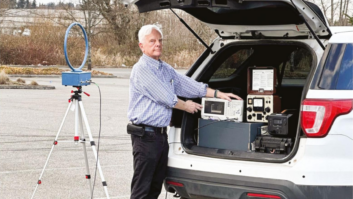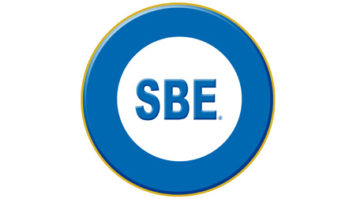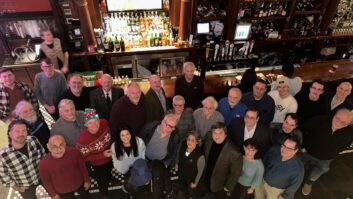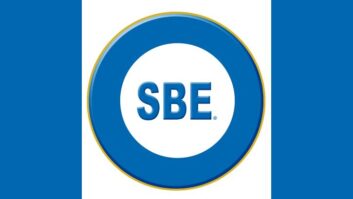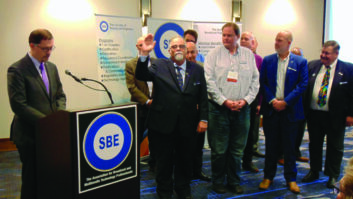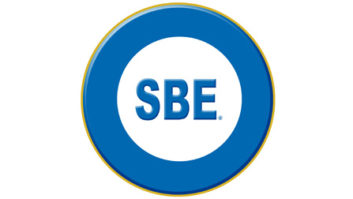The Society of Broadcast Engineers is looking for ways to maximize the education and training programs that broadcast engineers will need to succeed in an increasingly IT-centric workplace.
The SBE membership stands at 4,500 members in 116 chapters in the United States and Hong Kong. It also recently added a chapter in the Republic of Georgia; 10 engineers have joined that fledgling chapter, which will serve broadcast engineers in Georgia, Armenia, Azerbaijan and Moldova.
Membership has been slowly falling in recent years, according to SBE, from a peak of 5,918 in 2008. The organization says this is partly attributable to fewer people choosing broadcast engineering as a career and radio stations doing more with fewer people, along with increased equipment reliability and advancing technology.
The society offers an extensive list of educational programs for broadcast engineers, operators, technicians and broadcast IT professionals. It is led by President Andrea Cummis, CBT, CTO, and the national board, with support from Executive Director Jim Ragsdale.
Radio World: What was the biggest accomplishment of your 2022 national meeting in September?
Jim Ragsdale: The main effort was reviewing the goals from our last strategic planning session, which took place in 2018. The report identified a number of objectives aimed at connecting with our members more effectively and what their needs were.
One of the major things identified in 2018 was the complete rebuild from the ground up of our website, and that has been accomplished. And we now have a new survey that has been created to gather ideas for future planning. It will be shared with membership for their input. That’s step one. [Take the survey here.]
[Related: “SBE Expands Ennes Workshop at Spring Show“]
Andrea Cummis: And then the other major news was officially recognizing the new chapter in Georgia. That was one of our goals to get that finalized.
I would add that SBE Chapter 22 did a very nice job of hosting the national meeting. It was held in conjunction with their Broadcast and Technology Expo, which was very well attended. Our thanks to them.

RW: What priorities or initiatives has SBE put out there for the coming year?
Cummis: The number one thing is strategic planning and doing it in an entirely different way than in the past. Previously we would get 30 people from all over the country in a room for discussion. Now we have put together that 12-question survey Jim mentioned.
As part of that we’re asking for interest from members if they would like to be involved in a series of Zoom planning sessions. We hope to host a whole bunch of them to really find out what members really need from us.
Then maybe a smaller in person meeting near the end of the process.
RW: When do you envision these Zoom meetings commencing?
Cummis: If not late this year, then by early 2023.
RW: The Technical Professional Training program is two years old. It was meant to simplify steps to engage someone who is new to the broadcasting technical career path. Can you give us a status report?
Ragsdale: The TPT has been very effective. In fact, our mentorship program has grown and roughly doubled in numbers the past two years. Up to 120 now I believe are involved. Of that 50 are mentors. Many of the mentees have come through the TPT program.
We now have several state broadcast associations around the country offering scholarships for those interested in the TPT program. Missouri for one has granted a scholarship for that, and Nebraska is another. So we are getting good response from many of our peers asking how they can help to prepare new broadcast engineers for service in their state. The TPT program is a good way to do that.
[Related: “SBE Expands Its Mentor Program With Subject Matter Experts“]
RW: Are there other ongoing initiatives that are notable?
Ragsdale: The Ennes Educational Foundation has recently connected with Veterans-TV. They’re a non-profit that has obtained a donated broadcast truck and equipment that goes into the truck, to be used as a mobile studio classroom. Their goal is to train military veterans who have recently left the military in broadcast engineering and prepare them to work within the broadcast industry.
Our relationship is in the startup phase. Veterans-TV approached the Ennes Foundation about the project and the foundation agreed to provide scholarships and books for the program.
RW: Madam President, are there any goals you have set for the society for your second term?
Cummis: Handling the strategic planning is my main goal. We are also trying to plan some training sessions with Fred Baumgartner and NAB. But we are just getting those together. We would like to restart some of the things we used to do. We used to work with NAB on a lot of seminars.
Ragsdale: At the Broadcast Engineering & IT Conference we now really only have an hour of time specifically dedicated to broadcast engineering.
Cummis: So we are trying to reclaim that territory and restart some of our own training. [Read an update about the Ennes workshop here.] And another goal is expansion. It seems like it’s going to be hard to expand much in the U.S., so gaining that new Georgia chapter was big in our efforts to become a real international organization.
RW: Jim, you’re fairly new in your role as executive director, what have you learned about broadcast engineers and the society so far?
Ragsdale: I’ve been here since January of 2021. The most significant thing I have seen is just how tight-knit the group of people is and how committed they are about developing each other’s expertise. That has really played out in the SBE’s certification and education.
If you look at our education programs, they are for the most part member-prepared and member-delivered. That just goes to show the commitment among members to share their knowledge and strengthen the talents of fellow members.
We understand we have an aging membership base. We have understood for years that we need to do a better job of developing new broadcast engineers in the field. That has been a heavy part of my focus the past year and a half. Just trying to identify who those folks are who are currently not members but would benefit from membership. And get the word out about what we have to offer.
RW: Can you assess the overall health of broadcast engineering as a profession?
Ragsdale: I think sometimes we have too narrow of a focus in recognizing that there are people with similar skill sets who are not working in RF.
If you look at Bureau of Labor Statistics data, they have a job description called broadcast technician, and according to them there are 28,000 of those folks. A lot of those are not working in RF but they are doing something related. But 28,000 compared to our membership is a significant gap. So I think there is a lot of opportunity to reach people who would benefit from membership in SBE.
Cummis: I think there are a lot of people who don’t work in RF who feel they don’t belong in our group. For example, I do not work in RF. My background is all in production engineering and there are a lot of production engineers and production managers who feel they don’t fit in somehow because of our name.
RW: Could broadcast engineering eventually turn into a specialty arm of IT?
Cummis: Well they are certainly merging in some ways. And to be an engineer in a media situation you need to know a fair amount of IT. But I don’t know if IT people are necessarily going to be doing what we do. I’ve always found that not to work very well.
Broadcast engineers or media engineers typically can learn the IT side, since it is just another technology. But for people who start in IT, especially the help desk people, they are not ones to run around and help with emergencies. They are more likely to answer the phone and have you take a ticket; and when they get to you, they get to you. So I’m not convinced the professions are going to merge.
Another issue is that many broadcast engineering positions are union, where IT is not. So they can’t directly merge in the workplace. But it doesn’t mean the technology doesn’t overlap in certain places.
For information about the SBE, email James Ragsdale at jragsdale@sbe.org.
